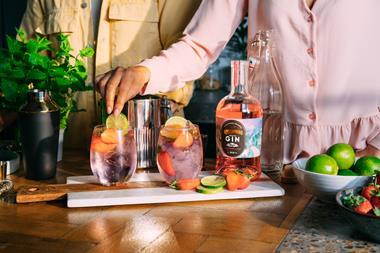The summer provides the perfect chance to turn up the heat on cider sales, with fruit flavours and traditional lines in greater demand.

Cider remains a true c-store staple, with almost half (48.1%) of UK households purchasing cider last year (Westons Cider Report – Autumn Update 2018). Whether it’s a West Country traditional or a modern fruity mix, cider certainly has a place in the convenience market.
No more so than at Bay Bashir’s five Go Local stores in Middlesbrough. “Our entire cider collection sells really well across all of our stores. It very much seems to be the drink of our area in a lot of ways,” Bay says.
Londis retailer Steve Bassett, who owns five stores across Dorset and Hampshire, agrees. “Cider is a great seller for us. We have a real variety, and they are all very popular,” he says.
With the summer sunshine just around the corner, both retailers are expecting big things from cider as the temperature rises, particularly flavoured cider.
Emmy Webster, senior marketing manager at Brothers Drinks, says: “Unsurprisingly, seasonality has a big part to play in cider sales within convenience and, as we move towards summer, we expect the popularity of fruit cider to soar with consumers looking for something light and refreshing to drink in the sun.
“For example, Brothers Toffee apple cider is more suited throughout winter months, whereas sweeter ciders, such as Brothers rhubarb & custard, are better for the summer months.”
Daniel Ritsema, co-founder of Cranes Drinks, believes summer provides an exceptional opportunity for the drinks category within convenience retail. “With the unpredictable English weather, if there’s a sunny weekend or warm day, the majority of consumers will opt to visit a convenience store for a quick purchase, to make the most of the sunshine. This is evident in cider sales, whereby Cranes Ciders experience more than 50% growth in the summer months across the full range.”
Kay Patel, who owns five Best-one and Global Food & Wine stores in East London, reports that all types of cider sell fantastically well over the summer months, but the classics are less popular than they once were.
He says: “Fruity cider sales shoot up massively across the summer months, and when the sun comes out in general. In the winter they do still sell well, but just nowhere near as much as in the summer holidays. Looking back at previous summers, sales of the standard ciders are slowly decreasing year on year.”
He adds that as a result he will be delisting some of the old classic brands. “Things like pear cider just aren’t sought after anymore, perhaps because of the rise of premium ciders, or the vast range of options. I am thinking about getting rid of Magners, too, which is the original big cider brand in my eyes.”
It’s a similar scene for Welcome Co-op franchisee Richard Inglis, who owns three stores in Southampton. “Cider is a much stronger seller in our stores in the summer period – it is much less of a winter drink. Come the summer, the more fruity options do sell better as a general rule,” he says.
“We are treating our cider area like we would any other section at the moment and are about to have a complete range review, where we will be dropping the weaker lines from the sales mix and making more of a focus on the stronger lines in time for summer.
“My current feeling is to trust the numbers and simplify the range. This will make it easier to manage in the busier summer months, enabling us to have more of the right products in our chillers to meet customer demand for fruity ciders.”
According to the Westons Cider Report – Autumn Update 2018, fruit cider makes up more than a quarter (25.7%) share of off-trade cider volume sales, with a 15.7% increase year on year.
Rosie’s Pig

Westons Cider has added to its Rosie’s Pig brand with a new rhubarb variant.
The 4% abv cider is available in a four-can pack and aims to respond to the two biggest trends in cider: fruit flavours and canned formats.
Alongside the launch of the rhubarb flavour, Westons has given the Rosie’s Pig brand a refresh, with a revamped look designed to give the products increased standout on shelf.
Rosie’s Pig rhubarb packs are the first to feature the modernised design, which carry an illustration of one of the first delivery trucks owned by Westons. The rebrand will be rolled out across all Rosie’s Pig ciders.
Westons Cider head of marketing Sally McKinnon says: “Interest in the fruit cider category shows no sign of letting up and there’s a clear opportunity to drive incremental sales by introducing new shoppers, such as younger drinkers and women to the category.”
Rosie’s Pig rhubarb is available in a four x 330ml can pack, with an rrp of £5.
In Bay’s stores, which cider sells best – fruity or traditional – depends not on the weather, but on the demographic of shopper. “The younger buyers and millennials are wanting the fruity flavoured ciders, maybe because it tastes a bit more like a soft drink, while the older generations still prefer the normal, traditional cider.
“The fruity ciders are growing in popularity all the time,” he adds. “We stock a wide range of ciders, but Kopparberg is our big front runner. We have seen that fly off the shelves. Having a variety is a must nowadays. I’m not really sure when the shift happened, but it doesn’t look like slowing down.”
Despite the rise in fruity flavoured ciders, sales figures still suggest there is certainly a place for traditional apple cider within the category.
Of all the apples grown across the UK, more than half (56%) are used to make cider (National Association of Cider Makers) and in the off-trade, traditional apple cider makes up 66.7% volume sales – a 1.1% increase year on year (Westons Cider Report – Autumn Update 2018).
Steve warns retailers that just because fruity sales may be going up, they should not get rid of the traditional lines altogether. “The volume of sales of traditional stuff doesn’t seem to be dropping even though the sales of fruity are going up. Maybe I’ve just got hardened cider drinkers in my area.
“We do a local cider from near our Weymouth store. It is so popular I put it into our Bridgwater store in Somerset, too. When I visit the Weymouth store, I pick up that cider and take it to the Somerset one and it sells better – even in apple country.
“The local stuff is very popular, but the traditional brands still lead the way. It is all about Thatcher’s in my stores. It is hard to get away from the traditional stuff, as customers clearly still enjoy it.”
The Westons Cider Report – Autumn Update 2018 states that traditional Strongbow (apple) and Thatchers Gold are the two top-selling off-trade cider products (excluding own label), with a total of seven traditional ciders making up the rest of the top 10.
Whether your customers prefer to stick with the traditional, or are partial to a fruity mix, the debate of cans vs bottles continues to fizz.
Thatchers Cider off-trade sales director Chris Milton says: “Cans drive market performance, so a must-stock for maximising category sales is to have Thatchers Gold on shelf. It’s the number two canned apple cider in value terms and is enjoying continued growth in shopper numbers.
“Cider in cans continues to drive market performance, with value sales up 14.8% and volume sales up 11.4%. But it is important for retailers to have a well-considered range of premium cider in both cans and bottles on shelf,” he concludes.
Ritsema at Cranes Drinks says: “Cans are set to pave the way, particularly within convenience retail this summer where consumers are buying for immediate consumption, as cans are lighter to transport, tend to have a lower price point and are easier to dispose of and recycle.
“Traditionally, bottles have the perception of being more premium. However, the craft beer sector is leading the way in changing the perception of cans and they are experiencing a real demand within retail. Hence why Cranes’ ciders are launching cans this spring, to meet both consumer demand and increase listing opportunities within retailers.”
For Bay, the debate is one that is all too familiar. “The box packs and crates versus the single bottle sales is the biggest trend that we’ve noticed across our stores,” he says. “Some people seemingly prefer the multipack value for money, while others who want to drink it straight away or just want one or two, go for the single bottles.”
Richard is on the side of cans. “The new Smirnoff cider bottles are struggling for sales across all of our stores – a bit like a lot of bottled cider.”
Kopparberg customer marketing manager Tom Holmes highlights the importance of bottled ciders, but believes canned alternatives are the future frontrunners of the category.
“Some £2 of every £3 spent on Kopparberg goes through single bottles,” he says. “While the format performs well, growing at 3%, Kopparberg’s growth stems from the canned ranges which have seen 38% growth year on year as impromptu summer occasions drive customers into four-packs.
“A large bulk of volume (57%) goes through can packs, as heavy promotions and larger pack sizes have seen the format grow at 9% in value and 4% in volume.”
While cider cans still hold the majority of market share, with 48.6% share of total cider and perry volume (IRI, February 2019) in the off trade, bottled cider still plays an important role within convenience.
Sheppy’s Cider head of sales Melanie Timmins stresses the importance of bottled cider. “Although cans provide an alternative for a growing demographic of craft drinkers, bottled cider is still the major force in stores,” she says.
Will Firby, founder of The Garden Cider Company, agrees. “Bottled drinks tend to be regarded as being more premium than canned, so if you are trying to encourage customers to trade up and maximise your profit, then bottled is the way to go. When introducing a new brand or flavour, multibuy deals and discounts tend to be effective in encouraging customers to try more premium products.”
Steve says he has experienced this first-hand in his stores. “The smaller bottles of cider are the ones that seem to shoot off the shelves. Customers seem to edge towards them in my stores,” he says.
Old Mout grows with pineapple and berry combo
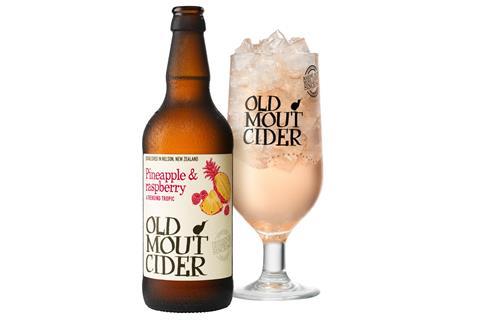
Heineken has added a new pineapple & raspberry flavour cider to its Old Mout core range.
Old Mout pineapple & raspberry (4% abv), offers a tropical taste with no artificial colours, flavours or sweeteners. It is available now in a single 500ml bottle (rrp £2.39) and 10x330ml can pack (rrp £11) .
Heineken cider director Emma Sherwood-Smith says: “Old Mout’s new pineapple & raspberry flavour reflects current market trends and we have the consumer taste tests to back it up – in fact, it received the second highest score in the history of Heineken UK.
“As such, we believe we have an exceptional, exotic flavour that will have mass appeal, delivering on 2019 foodie trends, great taste and marrying nicely with our sustainability agenda, too.”
She adds: “A recipe set for success, Old Mout’s latest npd is guaranteed to help retailers realise the full potential of their premium cider offering and boost their profits.”
Low / no alcohol
With a quarter of young adults in the UK now teetotal (BMC Public Health Journal), it’s little surprise that there are more low- or no-alcohol alternatives now on the market.
“Consumer demand for healthier options is impacting all channels and ensuring convenience stores cater for this is an important consideration. Kopparberg Light as an option performs well and would help to satisfy demand,” says Holmes.
“On top of that, alcohol-free is a rapidly growing segment within the category and Kopparberg has the highest number of shoppers of any alcohol-free brand in the UK, across all beer, wines and spirits.”
Kay reports increased sales volumes of low- and no-alcohol ciders. “We have seen an unprecedented sales increase of low- and no-alcohol ciders in recent times. We only stock the Kopparberg alcohol-free ciders at the moment, because we know they will fly off the shelves,” he says. “I am interested in getting in the Old Mout low-alcohol ciders, too. I have heard good things about them, so I think that’ll be my next step.
“It is just all based around customer demand for us. Health is ever more in focus for our consumers and we must react to that. First it was sugar-free soft drinks, then gluten-free food and now low- and non-alcoholic drinks.
“As long as they’re buying something, I don’t mind if it’s got alcohol in it or not.”
Timmins attributes the rise in low- and no-alcohol sales to “a shift in consumer lifestyle choices”.
“Low and no-alcohol purchases have experienced an increase of 57% over the past two years in the off-trade, which can be attributed in part to a shift in consumer lifestyle choices as people become more mindful of their health,” he says. “With millennials leading the way, this trend is set to continue and retailers need adapt to this ever-increasing demand for low- and no-alcohol alternatives.
“Advocates of the category now expect quality and variety without needing to compromise on taste, and so retailers should look to fill this space with a high-quality and trusted alternative.”
Whatever the percentage abv, ensuring that your cider is cold during the summer months is vital. “The main thing in the summer is to make sure it is all chilled,” asserts Bay. “We see a massive increase in sales if the ciders and all our alcoholic drinks are chilled. You have to merchandise it correctly to get the most out of the footfall. In the summer months, people are just coming in for that sort of stuff, so a fridge stocked with chilled ciders is a must.”
Richard feels the same. “Part of the reason sales do pick up for even the lesser-sold ciders over the summer months is largely because the main lines sell out so quickly that people just grab the coldest stuff they can find.”
Holmes says the key to making the most of cider sales is to understand the key trends, brands and flavours and consider the customers’ shopping mission. “This will allow you to strip out a level of unnecessary duplication, while maintaining a broad enough offering. Shoppers are often on a buy-for-now or buy-for-tonight mission in convenience, so smaller pack sizes and, where possible, a chilled range is ideal to meet demand.”
Holmes adds that as space is often at a premium within convenience, retailers need to “back the winners”. “Make sure fast-moving lines have enough facings to minimise the need for constant replenishment. Smaller pack sizes work well in fridges due to having a more immediate drinking occasion, and highlight npd in key space at eye level to give it the best chance to perform,” he says.
Brothers Drinks’ Webster has a number of tips for convenience retailers: “The best merchandising in convenience needs to be impactful and on display wherever possible, whether that be on shelf or in a chiller. Convenience is usually an impulse shop so any merchandising needs to influence the customer at the point of purchase,” she says.
“This could be impactful shelf barkers, wobblers advertising a brand, the category deal or consumer incentive to buy, such as a competition. Freestanding display units are a great way to influence the shopper, but these can be hard to site due to the lack of space in some c-stores and also do not allow the product to be chilled.”
Geographic location and making the most of the brands local to your area are key techniques that should be considered by all retailers, according to Timmins.
“Something that convenience store owners should consider is creating features based on geographic location. There is a strong appeal for provenance within the cider category and this can be communicated in store,” she says.
“Locally produced ciders can be stocked alongside other regional gins, whiskies and beers, to create a provincial offering that will engage customers. Offering a selection of complementary regional products can have a positive effect on sales.
“As well as sharing shelf space with alternative drinks, we find that merchandising cider alongside pairing foods such as local meats and cheeses can be an equally successful way of engaging with customers.”
Thatchers Rascal Cider renamed and revamped
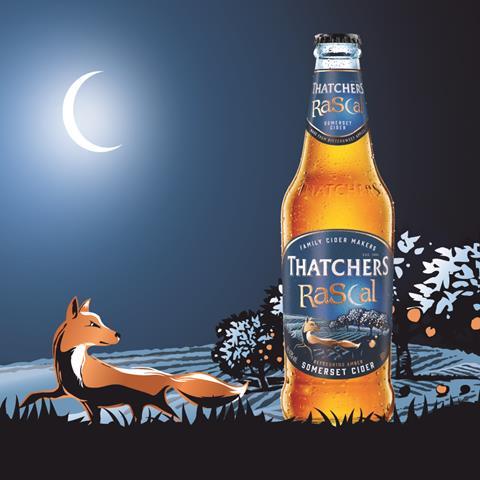
Thatchers is celebrating the renaming of its Rascal cider with a new-look bottle design.
Formerly known as Old Rascal, the revamped amber drink (4.5% abv) now comes packaged in a clear and recyclable bottle.
The move is being supported with a trade, experiential, social media and PR programme.
Thatchers cidermaker Martin Thatcher said: “It’s a premium cider that offers complexity within its bitter-sweet character. At 4.5% it’s refreshing, boldly bitter-sweet, yet surprisingly smooth with no challenging dryness. It presents the drinker with characterful apple cider and a roguish depth, for those who are looking for something different and away from the mainstream.
“The label has changed, but the beautiful character and flavour of the cider stays exactly as it always has.
“Drinkers will recognise the smooth, appley character and we hope through a new campaign to introduce many new drinkers to this traditional, bitter-sweet cider.”
The new-look Rascal Cider is available in 500ml bottles with an rrp of £1.85.






















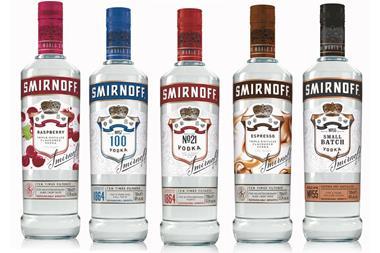
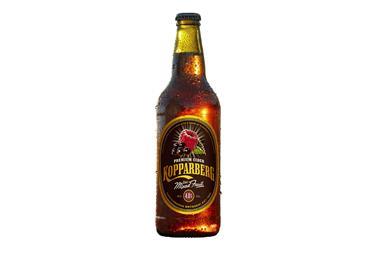
![Old Mout x WWF[4]](https://d2dyh47stel7w4.cloudfront.net/Pictures/380x253/7/2/2/160722_oldmoutxwwf4_73272.jpg)
